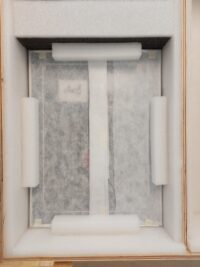Transporting artwork requires precision, care, and an in-depth understanding of materials and packaging techniques. At EnviArte, we know that each artwork is unique, and protecting it during shipping is as important as the artwork itself. Whether it’s a large-format painting, a delicate sculpture, or a contemporary installation, we apply specialized methods to minimize any risks.
Below, we outline the key steps we follow to ensure your artwork travels safely, remains intact, and arrives in the same condition as it was shipped.
Personalized Artwork Assessment
Before preparing any shipment, we conduct a thorough assessment of the artwork. This evaluation includes factors such as the artwork’s material, size, shape, weight, and fragility. Packing a marble sculpture is not the same as packing an oil painting on canvas, and each of these elements requires a specialized approach.
This first step is essential as it enables us to select the most suitable packaging materials and techniques for each case. Additionally, we identify potential points of vulnerability in the artwork, such as areas more sensitive to impact, vibrations, or temperature changes.
Selection of the Best Packaging Materials
Packaging is the first line of defense for protecting artwork during transport. At EnviArte, we use a combination of materials specifically designed for art’s unique needs. Some of our most frequently used materials include:
- Acid-Free Tissue Paper: Ideal for wrapping paintings or delicate surfaces. Being acid-free, it does not harm sensitive materials.
- Polyethylene Foam: Cushions against impact and vibration, offering firm, lightweight protection.
- Corrugated Cardboard and Custom Boxes: We custom-make wooden crates so that the artwork travels securely within them. Additionally, we use double or triple-layer corrugated cardboard for added durability.
- Wooden Crates: For more delicate or valuable works, we use reinforced wooden crates that provide maximum protection against impacts and compression. These crates typically feature an internal foam or padded lining to prevent movement inside.
Layered Packaging
One technique we frequently use is layered packaging. This involves wrapping the artwork with several types of protection, starting with softer, more delicate layers like tissue paper or bubble wrap, and finishing with more robust materials like corrugated cardboard or wooden crates. This combination ensures that the artwork is protected from all angles and against any type of eventuality.



















